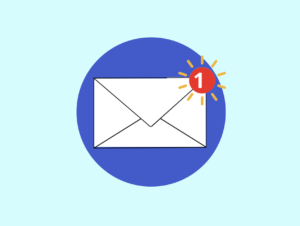Which Email Marketing Strategy Will Help Me Reach My Goals?
August 18th, 2020 by
Key Insights
- Email marketing is still 100% relevant
- Establish specific goals for your email marketing campaign
- Determine the metrics you want to measure before executing your campaign
- Think of conversion and retention campaigns as umbrella campaigns. Choose a more specific subset campaign once you decide which aligns best with your marketing goals
You may have gotten a notification in your email inbox about this blog. Or, you started your morning organizing the daily or weekly emails in your inbox. Hello, email marketing!
Yes, we’re still talking about email as an effective marketing strategy in the age of TikTok and Instagram. When done correctly, email campaigns can help businesses build brand loyalty and nurture potential leads into customers. Companies have the chance to get directly in front of their audience,—99% of consumers check their emails every day—while exhibiting the value of their products and services.
Remember: if your audience chose to subscribe to your email list, they have some interest in your brand. Don’t waste their time with irrelevant content that has them reaching for the “Unsubscribe” button.
In this post, we’ll define conversion and retention email campaigns, explore campaign types within those categories (campaign-ception!), and find the right email marketing strategy for your campaign.
Determine Your Goal: Conversion or Retention?
Before you decide on a strategy, you need to identify your main goal. Do you want your campaign to result in X% more subscribers buying a product or downloading an ebook? Perhaps you want only X% to Y% subscribers to hit “unsubscribe” in the next quarter or X% more engagement with your content.
These are examples of conversion and retention goals—now, let’s find out which type of goal is for you! Think of conversion and retention campaigns as umbrella campaigns. Once you decide which aligns best with your marketing goals, you’ll choose a more specific subset campaign.
Once you pick a goal that’s S.M.A.R.T. (specific, measurable, attainable, relevant, and time-bound) and your metrics to measure, you’ll know if your email marketing strategy should be a conversion or retention campaign.
Conversion goals focus on your subscribers completing the desired action prompted by your email.
Examples:
- Download an ebook
- Purchase a product
- Fill out a form
- Register for a service
Retention goals focus on keeping your subscribers engaged and satisfied with your brand. You can measure their success by monitoring how subscribers interact with your emails.
Examples:
- Rate of subscribers vs. unsubscribers
- Open rate
- Click-through-rate
- Content engagement
Conversion Email Campaigns
Conversion email campaigns focus on building brand loyalty and establishing trust with potential leads that have shown interest in a business’s product or service. They nurture leads through the buyer’s journey with the ultimate goal of, you guessed it, conversion.
If your industry has a more extended buyer’s journey, conversion campaigns nurture prospects from the top of the marketing funnel and through the entirety of your buyer’s journey.
The first email in a conversion campaign won’t end with “buy now.” You’ll have to build trust with your audience before we get there! (However, if your buyer’s journey is on the shorter side, you can always adjust your email campaign’s length).
Drip Campaigns
A drip email campaign is a multi-email strategy that targets your leads along every stage of the marketing funnel. Drip emails are relatively simple to set up and can be great tools for a quick-start campaign.
Purpose: Drip emails are sent at regular intervals to potential leads. Each email is connected to an overarching goal or strategy.
Recipients: Recipients are potential leads identified in real-time or when they take a specific action (e.g., fill out a landing page form) that serves as a catalyst to start the drip campaign.
Content: Content will align with your marketing funnel. Campaigns typically start at the top of the funnel with more general content (introductory information, overview) and eventually lead readers to content encouraging decision-making. A specific call-to-action will be outlined in each email.
Timing: These emails are sent automatically according to an established campaign timeline.
Possible Metrics: Open rate, click rate, and the desired conversion.
Nurture Campaigns
Nurture email campaigns are similar to drip campaigns, but they’re even more detailed and contain many moving parts.
Purpose: Readers are nurtured through the marketing funnel by content sent over a period of time, ultimately leading them to the desired action.
Recipients: Similar to drip campaigns, recipients are potential leads that are identified in real-time or when they take a certain action (e.g., fill out a landing page form) that serve as a catalyst to start the nurture campaign.
Content: Content should be tailored to your marketing funnel and your lead’s behavior. They should receive specific content based on which action they took. Did they request general information? Have they downloaded your ebook? Content could include F.A.Q.’s, testimonials, additional information, benefit stories, and a call-to-action leading them to the next step in the funnel.
Timing: Communication is automated with a customized timeline based on a set of defined actions (unlike drip campaigns that follow one general schedule). If your lead takes the desired action, they stop receiving one series of emails and move on to the next email series (or another step.)
Possible Metrics: Open rate, click rate, desired conversion, and length of time in each email segment.
Retention Email Campaigns
While both conversion and retention email campaigns do build trust with readers, retention campaigns focus more on trust than promoting products or services. Customers receiving these emails fall into the “Delight” stage of the marketing funnel. Delight content focuses on maintaining the loyalty of established customers.
You want to retain customers and build brand loyalty by delighting and engaging them with helpful updates, promotions, sales, news, and upcoming events—delivered right to their inbox.
Here’s what that this looks like:
One-Off Campaigns
One-off email campaigns are short, sweet, and focused.
Purpose: These email(s) offer specific promotions or timely events your business is running.
Recipients: Those already familiar with your brand, such as subscribers who have already made a purchase or leads near the bottom of your marketing funnel.
Content: Keep it short and visual! Content should be easily skimmable and focused around eye-popping graphics.
Timing: Timing will vary with the offer and strategy. You can send out multiple emails leading up to the event or just send one the day of to create a sense of urgency.
Possible Metrics: Open rate, click-through-rate, and visiting a specific site page.
Newsletter Campaigns
Newsletter email campaigns are non-promotional and sent out periodically to customers.
Purpose: Update customers about your business and establish a sense of loyalty and trust—you’re not asking them to convert!
Recipients: Broader audiences that have subscribed to your mailing list. Your audience can be at different levels in your marketing funnel, but they are usually familiar with your brand.
Content: Newsletters contain topical company news, important updates, helpful tips, and other content that makes readers feel like an insider at your business.
Timing: Campaigns are recurring and regularly occur monthly or quarterly.
Metrics: Open rate, click-through-rate, and unsubscribe rate.
Email campaigns can be an excellent marketing tool with a pretty impressive R.O.I.—it can generate $38 for every $1 spent! If you’re not sure where to start, contact our team at Search Influence. Together we can help craft, set up, and optimize an email marketing campaign that’s tailored to your goals.
Images:



